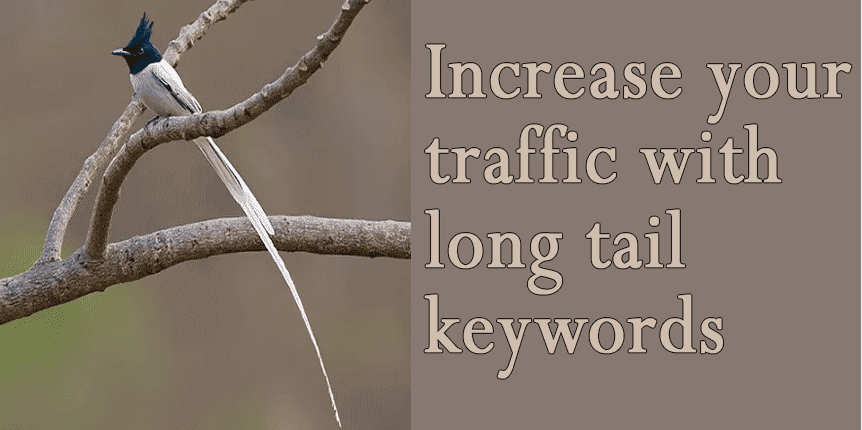Do you know what are long tail keywords? How can you use them, incorporate them, into your content writing? What are the benefits of using long tail keywords when writing content for your website or blog?
In terms of improving your SEO, the concept of long tail keywords isn’t something new. It has been around for many years, but you come to know of it only when you do some careful reading, some persistent reading.
What are long tail keywords?
The phrase “long tail keywords” originates from the dragon-like long tail the traffic graph of long tail keywords generates.
Long tail keywords are those keywords that are low competition, that is, not many people are searching for them, but if some people are searching for them, and if you have optimized your web page or blog post for those long tail keywords, your link can be found by them easily.
To understand better, look at the image given below:
As you can understand, it would be very difficult for me to rank for the phrase “content marketing”. Aside from the fact that it makes no sense to optimize for this particular phrase for me right now simply because no intent can be attributed to the phrase “content marketing”, since thousands of people are already ranking above me, it wouldn’t be worth it for me to spend so much effort trying to rank higher for it.
Although this keyword or phrase is very competitive and may generate lots of traffic for websites ranking high for this keyword, in terms of competition and conversion, it has no value for me.
“Content marketing for my website” on the other hand is a clearly-defined phrase that I would like to rank higher for. A person who wants to use content marketing to promote his or her website should be able to find my website.
But again, it is a highly competitive phrase, though, it can be termed as, by definition, a long tail keyword because it contains more than three words.
Still, thousands of businesses might be looking for “content marketing for my website” because, well, one, almost every business these days has a website, and two, almost every business wants to promote itself some way or the other, and among these businesses, who are aware of the concept, would like to use content marketing to promote themselves.
Now we come to “content marketing for my web design website”. It’s an out and out long tail keyword because fewer people (compared to the two phrases described above) are searching for it and hence, it is not as competitive as the keywords mentioned above.
So, it is easier to rank higher for this phrase and since it is easier to rank higher, even if fewer people are searching for it, it can generate decent traffic.
This example can be applied to any business.
Suppose you sell “handwoven socks” from your website. Although it is a very attractive keyword or key phrase, thousands of people might be searching for “handwoven socks”. On the other hand, if you try to rank for “handwoven socks for babies” or “blue handwoven socks with white pattern” it will be easier to rank higher and get very specific traffic with greater conversion rate.
Such keywords or phrases are called long tail keywords; they are normally 3-4-5 words long and are very specific.
Why you can ill afford to ignore long tail keywords
Long tail keywords are also important because most of your traffic is already coming, or is going to come, from mobile devices. On mobile devices, since search is supported by voice, people tend to use phrases or common sentences to search for information.
There is a greater possibility of someone searching for “content writing service for my boutique website” then “content writing service”.
So, it is better to optimize for search terms and keywords your prospective customers and clients are actually using.
Another big reason is, the more specific the search is, the greater is the chance of the person buying from you.
This is where “intent” comes in.
If someone is searching for “content marketing” you never know what she is looking for.
Does she want to learn about content marketing? Does she want to find websites on content marketing? Is she a journalist writing an article? Maybe she is looking for books, articles and blog posts on content marketing? You can never be sure.
Even if someone is searching for “content marketing for my business” you cannot be sure whether she is looking to hire someone, or she wants to do it on her own.
“Content marketing service for my business” is more targeted and it means someone is looking for a content marketing service for her business.
“Content marketing service for my interior design website” is even more targeted. You know precisely what she is looking for.
Targeting for long tail keywords gives you an edge because it sends you highly targeted traffic that in turn, improves your conversion rate.
How to improve your SEO and double, or even triple your traffic with long tail keywords
As I have already explained above, since long tail keywords are less competitive in terms of SEO and may attract even less traffic, since they are more targeted, they enjoy better conversion rate and easy, higher search engine rankings.
You can either use common sense to create a list of long tail keywords pertaining to your business, industry or profession, or you can use something like LongtailPro (disclaimer: affiliate link) to find the long tail keywords in your niche.
With LongtailPro, you can enter a “seed” keyword and based on that, the app will suggest all the combinations that you can optimize your content for.
A good thing about LongtailPro is that along with giving you all the possible suggestions, it also shows you how competitive a particular phrase is for your website, specifically, and how many queries are done using the phrase for the long tail keyword.
If you don’t want to use LongtailPro, you can also use the Google AdWords tool. Just be wary, since Google would like you to bid on maximum number of keywords and phrases, it throws at you all sorts of keyword combinations that may confuse you. It is better to use the tool to get the ideas but eventually, create your own list, manually.
Remember that the amount of search engine traffic that you get is not important, what is important is, how many people do business with you. For that, you need to target very specific keywords and search terms.
Once you have created the list, start creating content around those long tail keywords.
The best thing to do is, create a web page or blog post with the title having your long tail keyword. For example, I can have something like “How to use long tail keywords for content marketing?” or “how my content writing service can help your restaurant website?”
If you have a TV shop in Lajpat Nagar it doesn’t make any sense trying to optimize for “Sony TV”.
On the other hand, you should optimize for “TV shop in Lajpat Nagar” or better, “Sony TV shop in Lajpat Nagar”, or even better, “Leco Sony TV Lajpat Nagar”, because this is how people search when they really want to buy.
Below I’m summing up how and why optimizing for long tail keywords can improve your search engine rankings as well as conversion rate:
- Long tail keywords are less competitive in terms of SEO and hence, you can easily rank higher for them
- Since you can easily rank higher for them, even if fewer people are searching for them, they will come to your website
- Since search terms for long tail keywords are very specific, the traffic generated through these keywords have a clearly-defined intent and this is why, they enjoy a greater conversion rate
In fact, while writing content for my clients, I have experienced that writing content for long tail keywords is a lot easier than writing content for generic, high competition keywords because, since long tail keywords use logical phrases, it is easier to write conversational, engaging content for them.



